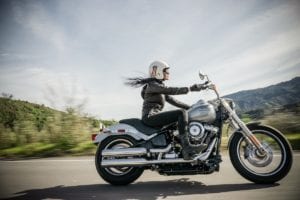Louisiana Road Safety: Important Motorcycle Laws
September 25, 2019 @ 9:30 am

As the number of bike enthusiasts continues to grow and more cyclists drive more miles, the likelihood of being involved in a motorcycle accident increases too — even when motorcyclists are doing everything right.
In 2018, the National Motorcycle Institute released Nobody Told Me That Motorcycles Are So Dangerous, a paper on understanding the danger of motorcycling in the USA. The report claimed that driving a motorcycle is 38 times more dangerous than driving a car — even when motorcycle drivers do everything right.
The first step for all of us toward keeping motorcyclists safe and avoiding accidents is to understand the laws governing motorcycle use.
Louisiana Motorcycle Laws
- RS 32:408: Operators must have an M endorsement on their license. In order to operate a motorcycle, motorized bicycle, moped or other motorized vehicle in excess of 5 horsepower on Louisiana’s streets, roads or highways, drivers must earn an M endorsement on their driver’s license. An M endorsement says that the driver has either passed a motorcycle road rules test and skills test or has completed a Department of Public Safety Motorcycle Safety Awareness and Operators Training Program.
- RS 32:190: Motorcycle-rated helmets are mandatory. Anyone—driver and passenger—riding on a motorcycle must wear a helmet made for motorcyclists. Helmets must have a lining, padding, a visor and a chin strap, and the chin strap must be fastened when the bike is in use.
- RS 32:190.1: Eye protection is mandatory. The motorcycle must have a windshield that is tall enough to protect the driver’s eyes, or the motorcyclist must wear eye protection designed for that purpose—goggles or a visor, for example. Nighttime driving requires that eye protection be clear and free of any tint.
- RS 32:191: Operators must have unimpeded control of their bike. Motorcyclists must be sitting on their bike properly—on a permanent seat, facing forward. Operators are not allowed to carry any bundles or packages that would interfere with their ability to keep both hands on the handlebars; both hands must be free to control the bike. They’re also not allowed to carry any passengers that might interfere with their ability to see or operate the vehicle safely.Any passengers must ride either astride on a permanent passenger seat or in an appropriate seat attached at the rear or side. Any child passengers must be at least 5 years old and must wear a helmet. Infant or child safety seats are not permitted.
- RS 32:191.1: Lane laws apply to motorcycles. Motorcycles have the right to an entire traffic lane all to themselves, and other vehicles should not deprive motorcyclists of any portion of that lane. Likewise, no motorcyclist should attempt to share a lane with another vehicle or ride between lanes. Bikes are specifically prohibited from going between rows of vehicles—to pass through slow or stopped traffic, for example. Motorcyclists can ride side by side in one lane but with no more than two abreast.
- RS 32:191.2: Driving tows are not allowed. Motorcyclists cannot attach themselves or their bike to another vehicle on the roadway.
- RS 32:191.3: Handlebars and footrests must be safe. Motorcycle handlebars cannot force the operator’s grip to rise above their seated shoulder height. The maximum height is 15 inches above the seat. Motorcycles must be equipped with footrests for passengers riding astride.
- RS 32:303, 304, 305 and 306: Proper lighting is mandatory. Motorcycles must have at least one white headlamp (no more than two), at least one red tail lamp that is plainly visible at 1,000 feet and clearly illuminates the rear registration plate, at least one red rear reflector and at least one stop lamp. However, motorcycles are not required to have electronic turn signals, but motorcyclists must use accepted hand signals if they don’t have them.
- RS 32:341: A brake on each wheel is mandatory. The brake can be operated by hand or foot, but to pass inspection, motorcycles must have a working brake on each wheel.
Motorcyclists also have the same responsibilities of other drivers. These include obeying all traffic safety laws, registering their bikes and keeping that registration and plate current, complying with yearly safety inspections and maintaining current liability insurance required by Louisiana law.
Accidents Involving Motorcycles in Louisiana
In Southern states with mild climates, motorcyclists enjoy the roads year-round, increasing yet again the likelihood that you’ll at least see one in your daily travels. Take care to give bikes the space they’re due. A motorcycle may have just one stop or brake lamp, and it may or may not have the electronic turn signal lamps that other motorists may be counting on.
If you’re a cyclist suffering from a wreck or a motorist who’s been involved in one, you may need legal help from a personal injury lawyer experienced in motorcycle accidents. You may be due compensation for personal injuries, property damage, lost wages or pain and suffering that insurance companies or other parties at fault may be reluctant to pay. Call 800-356-6776 to speak with one of the personal injury attorneys at Morrow, Morrow, Ryan, Basset and Haik, or schedule your free consultation with us online.
